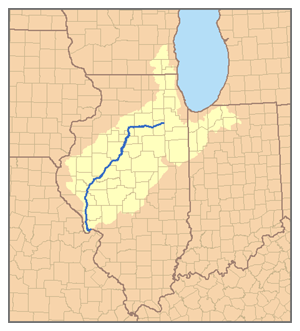| Illinois River | |
|---|---|
 Illinois River valley, Abraham Lincoln Memorial Bridge, and LaSalle Rail Bridge near LaSalle, Illinois | |
 Map of the Illinois River watershed | |
| Location | |
| Country | United States |
| State | Illinois |
| Physical characteristics | |
| Source | Confluence of the Kankakee and Des Plaines Rivers |
| • location | Grundy County, Illinois, United States |
| • coordinates | 41°23′37″N 88°15′37″W / 41.39361°N 88.26028°W |
| • elevation | 505 ft (154 m) |
| Mouth | Mississippi River |
• location | Grafton, Illinois, United States |
• coordinates | 38°58′13″N 90°27′15″W / 38.97028°N 90.45417°W |
• elevation | 417 ft (127 m) |
| Length | 273 mi (439 km) |
| Basin size | 28,070 sq mi (72,700 km2) |
| Discharge | |
| • location | Valley City, about 61.8 mi (99.5 km) from the mouth[1] |
| • average | 23,280 cu ft/s (659 m3/s)[1] |
| • minimum | 1,330 cu ft/s (38 m3/s) |
| • maximum | 123,000 cu ft/s (3,500 m3/s) |
| Basin features | |
| Progression | Illinois → Mississippi → Gulf of Mexico |
| Tributaries | |
| • left | Kankakee River, Mazon River, Vermilion River, Mackinaw River, Sangamon River |
| • right | Des Plaines River, Fox River, Illinois and Michigan Canal |
| [2][3] | |
The Illinois River (Miami-Illinois: Inoka Siipiiwi[4]) is a principal tributary of the Mississippi River at approximately 273 miles (439 km) in length. Located in the U.S. state of Illinois,[5] the river has a drainage basin of 28,756.6 square miles (74,479 km2).[6] The Illinois River begins with the confluence of the Des Plaines and Kankakee rivers in the Chicago metropolitan area, and it generally flows to the southwest across Illinois, until it empties into the Mississippi near Grafton, Illinois. Its drainage basin extends into southeastern Wisconsin, northwestern Indiana, and a very small area of southwestern Michigan in addition to central Illinois. Along its shores are several river ports, including Peoria, Illinois. Historic and recreation areas on the river include Starved Rock, and the internationally important wetlands of the Emiquon Complex and Dixon Waterfowl Refuge.
The river was important among Native Americans and early French traders as the principal water route connecting the Great Lakes with the Mississippi. The French colonial settlements along these rivers formed the heart of the area known as the Illinois Country in the 17th and 18th centuries. After the construction of the Illinois and Michigan Canal and the Hennepin Canal in the 19th century, the role of the river as link between Lake Michigan and the Mississippi was extended into the era of modern industrial shipping. The Illinois now forms the basis for the Illinois Waterway, extending the river's capabilities for navigation and commercial shipping.
- ^ a b "USGS Gage #05586100 on the Illinois River at Valley City, IL" (PDF). National Water Information System. U.S. Geological Survey. 1939–2012. Archived (PDF) from the original on May 15, 2019. Retrieved November 9, 2013.
- ^ "Illinois River". Geographic Names Information System. United States Geological Survey, United States Department of the Interior.
- ^ Rivergauges.com Archived April 8, 2009, at the Wayback Machine
- ^ "Aacimotaatiiyankwi : a Myaamia Community Bog". Archived from the original on September 1, 2018. Retrieved April 22, 2018.
- ^ Riverweb Illinois River basics Archived June 1, 2016, at the Wayback Machine
- ^ NHDPlus v2.1 Watershed Characterization Report Archived February 2, 2017, at the Wayback Machine